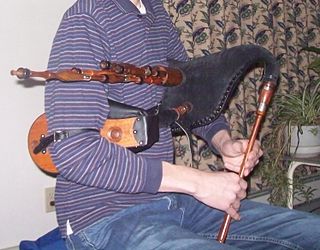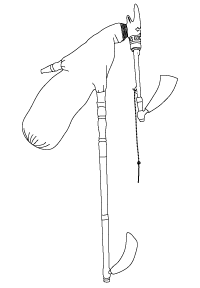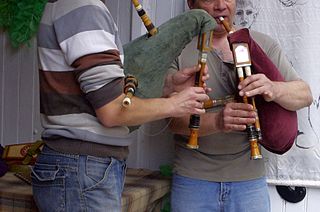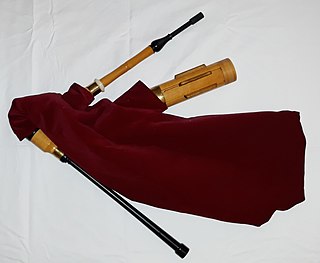
Bagpipes are a woodwind instrument using enclosed reeds fed from a constant reservoir of air in the form of a bag. The Great Highland bagpipes are well known, but people have played bagpipes for centuries throughout large parts of Europe, Northern Africa, Western Asia, around the Persian Gulf and northern parts of South Asia.

The uilleann pipes, sometimes called Irish bagpipes, are the characteristic national bagpipe of Ireland. Earlier known in English as "union pipes", their current name is a partial translation of the Irish language terms píobaí uilleann, from their method of inflation. There is no historical record of the name or use of the term uilleann pipes before the 20th century. It was an invention of Grattan Flood and the name stuck. People mistook the term 'union' to refer to the 1800 Act of Union; however, this is incorrect as Breandán Breathnach points out that a poem published in 1796 uses the term 'union'.

The chanter is the part of the bagpipe upon which the player creates the melody. It consists of a number of finger-holes, and in its simpler forms looks similar to a recorder. On more elaborate bagpipes, such as the Northumbrian bagpipes or the Uilleann pipes, it also may have a number of keys, to increase the instrument's range and/or the number of keys it can play in. Like the rest of the bagpipe, they are often decorated with a variety of substances, including metal (silver/nickel/gold/brass), bone, ivory, or plastic mountings.

The great Highland bagpipe is a type of bagpipe native to Scotland, and the Scottish analogue to the great Irish warpipes. It has acquired widespread recognition through its usage in the British military and in pipe bands throughout the world.

The Scottish smallpipe is a bellows-blown bagpipe re-developed by Colin Ross and many others, adapted from an earlier design of the instrument. There are surviving bellows-blown examples of similar historical instruments as well as the mouth-blown Montgomery smallpipes, dated 1757, which are held in the National Museum of Scotland. Some instruments are being built as direct copies of historical examples, but few modern instruments are directly modelled on older examples; the modern instrument is typically larger and lower-pitched. The innovations leading to the modern instrument, in particular the design of the reeds, were largely taken from the Northumbrian smallpipes.

The Northumbrian smallpipes are bellows-blown bagpipes from Northeastern England, where they have been an important factor in the local musical culture for more than 250 years. The family of the Duke of Northumberland have had an official piper for over 250 years. The Northumbrian Pipers' Society was founded in 1928, to encourage the playing of the instrument and its music; Although there were so few players at times during the last century that some feared the tradition would die out, there are many players and makers of the instrument nowadays, and the Society has played a large role in this revival. In more recent times the Mayor of Gateshead and the Lord Mayor of Newcastle have both established a tradition of appointing official Northumbrian pipers.

As Europe experienced a wave of roots revivals in the 1950s and 1960s, France found its regional culture reviving traditional music. Brittany, Limousin, Gascony, Corsica and Auvergne were among the regions that experienced a notable resurgence in the popularity of folk music. Traditional styles of music had survived most in remote areas, such as the island of Corsica and mountainous Auvergne, as well as the more nationalist lands of the Basques and Bretons.

The Hungarian duda is the traditional bagpipe of Hungary. It is an example of a group of bagpipes called Medio-Carparthian bagpipes.

A rauschpfeife is a capped conical reed musical instrument of the woodwind family, used in Europe in the 16th and 17th centuries. In common with the crumhorn and cornamuse, it is a wooden double-reed instrument with the reed enclosed in a windcap. The player blows into a slot in the top of the windcap to produce the sound.

The kortholt is a musical instrument of the woodwind family, used in the Renaissance period.

French bagpipes cover a wide range and variety of styles of bagpipes and piping, from the Celtic piping and Music of Brittany to the Northern Occitan's cabrette.

The Istarski mih or Istrian mih is a bagpipe native to the regions of Istria and Kvarner, Croatia.

The cabrette is a type of bagpipe which appeared in Auvergne, France in the 19th century, and rapidly spread to Haute-Auvergne and Aubrac.

Doedelzak is the name for bagpipes in the Netherlands and the Flemish (Dutch) speaking northern part of Belgium. This is the region where painter Pieter Bruegel the Elder lived and worked. Formerly pijpzak and moezelzak were common. The latter two names, generic at one time, survive in the piposa from Picardy and muchosa in the actual Belgian province of Hainaut. According to certain sources, muse once was the earliest generic name for this family of instruments in a large part of Europe and survives itself in the actual French generic name of cornemuse for all bagpipes.
The musette bressane is a type of bagpipe native to the historic French province of Bresse, in eastern France.

Kozioł refers to several variants of bagpipes native to a region of Poland surrounding the city of Zbąszyń.
Hugh Robertson (1730–1822) was a Scottish wood and ivory turner and a master crafter of woodwind instruments such as pastoral pipes, union pipes, and great Highland bagpipes.

Shuttle pipes are a type of bagpipes which derive their name from the drones used to produce the harmony. Rather than the long tube-like drones of most bagpipes, shuttle pipes use a shuttle drone, a cylindrical chamber enclosing a series of folded drone tubes, each terminating in a slot covered by a sliding "shuttle" which can be adjusted to lengthen or shorten the distance traveled by air moving through the tube, thus flattening or sharpening the pitch of the note produced.

Syntagma Musicum (1614-1620) is a musical treatise in three volumes by the German composer, organist, and music theorist Michael Praetorius. It was published in Wittenberg and Wolfenbüttel. It is one of the most commonly used research sources for seventeenth-century music theory and performance practice The second volume, De Organographia, illustrates and describes musical instruments and their use; this volume in particular became a valuable guide for research and reconstruction of early instruments in the twentieth century, and thus an integral part of the early music revival. Though never published, Praetorius intended a fourth volume on musical composition.


















